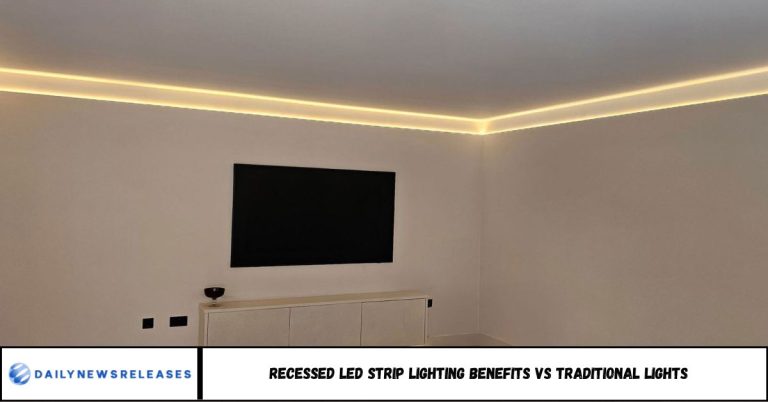Recessed LED strip lighting offers superior energy efficiency, design flexibility, and longevity compared to traditional lighting options. This article explores the key reasons homeowners, architects, and businesses are switching to LED technology. You’ll learn about energy savings, installation benefits, modern aesthetics, and long-term value—backed by current data and clear insights.
Lighting defines how a space looks, feels, and functions. The right illumination enhances visual appeal, boosts energy efficiency, and transforms ordinary interiors into captivating environments. As technology continues to evolve, recessed LED strip lighting has emerged as a cutting-edge alternative to conventional lighting systems.
This modern lighting solution delivers seamless, energy-efficient illumination that integrates effortlessly into walls, ceilings, and furniture. Unlike bulky fixtures or exposed bulbs, recessed LED strips stay hidden from view—creating a smooth, diffused glow that elevates any interior.
Today, architects, designers, and homeowners favor recessed LED strip lights for their clean aesthetics, flexibility, and superior performance. From residential spaces to retail showrooms and hospitality settings, this innovative approach to lighting design offers a perfect balance of style, sustainability, and sophistication, making it a clear winner over traditional lighting options.
Reasons Behind Choosing Recessed LED Strip Lighting over Traditional Lighting
Are your electricity bills climbing while your lighting still feels dull or outdated? Many homeowners and designers are rethinking how they illuminate spaces—and recessed LED strip lighting is leading the charge. Unlike traditional bulbs, LEDs blend style with sustainability, offering both visual appeal and measurable savings.
This article reveals why recessed LED strips outperform conventional lighting, explaining their energy efficiency, design flexibility, installation benefits, durability, and cost-effectiveness. Whether you’re upgrading your home or designing a modern office, you’ll understand why this lighting trend is becoming a smart long-term choice.
1. Energy Efficiency: The Smart Power Choice
According to the U.S. Department of Energy, LED lighting uses at least 75% less energy than incandescent and fluorescent lighting. Recessed LED strips are designed for continuous, low-energy illumination, reducing electricity consumption without sacrificing brightness.
Key advantages:
- Up to 80% lower power usage compared to traditional lights
- Minimal heat output, reducing air-conditioning costs
- Higher light efficacy (lumens per watt) for better brightness
This means every watt counts—literally—making LED strips ideal for energy-conscious users.
2. Sleek Design and Space Optimization
Traditional lighting fixtures can be bulky or intrusive. In contrast, recessed LED strips integrate seamlessly into walls, ceilings, shelves, or floors, creating a clean, minimalist aesthetic.
Why it matters:
- Perfect for modern interiors seeking subtle illumination
- Enhances architectural details and textures
- Allows for custom light layering, improving ambience and mood
Their flexibility means designers can bend, curve, or angle the strips to match creative layouts—something traditional lights can’t easily achieve.
3. Longer Lifespan and Durability
The average LED lifespan ranges from 30,000 to 50,000 hours, compared to roughly 1,000 hours for incandescent bulbs. Recessed LED strips also resist vibrations, heat fluctuations, and frequent switching, making them a long-term investment.
Benefits include:
- Fewer replacements and lower maintenance costs
- Consistent light output over time
- Eco-friendly materials with reduced waste
This longevity makes them ideal for both residential and commercial installations.
4. Cost-Effectiveness Over Time
While LED strips may cost more initially, their energy savings and low maintenance lead to greater financial benefits in the long run. Studies show that LED systems can reduce lighting costs by up to 70% annually compared to older lighting technologies.
In simple terms:
- Lower monthly bills
- Fewer bulb changes
- Reduced maintenance labor
When viewed as a 5- to 10-year investment, recessed LED lighting easily pays for itself.
5. Eco-Friendly and Sustainable Lighting
Environmental responsibility is now a key design priority. Recessed LED strip lighting aligns perfectly with green building standards:
- Contains no mercury or harmful gases
- Emits less carbon dioxide during operation
- Compatible with smart dimmers and motion sensors for optimized usage
As more cities and companies aim for carbon neutrality, LED lighting supports sustainability goals while improving everyday efficiency.
6. Easy Installation and Smart Control
Unlike bulky light fixtures, LED strips can be installed in narrow spaces and controlled remotely. Many modern systems include smart features, allowing users to change color temperature, brightness, or scheduling through mobile apps.
Smart advantages:
- Remote dimming and color control
- Compatibility with Alexa, Google Home, and Apple HomeKit
- Quick-fit mounting channels for effortless setup
The combination of simplicity and smart control makes recessed LEDs ideal for both DIY projects and professional installations.
7. Versatility Across Applications
From residential interiors to retail and hospitality, recessed LED strips offer unmatched versatility. They’re used for:
- Under-cabinet lighting in kitchens
- Cove lighting in living rooms or hotels
- Accent lighting for art, furniture, or displays
Their ability to transform ordinary spaces into visually appealing environments makes them a favorite among interior designers and architects alike.
FAQs
1. Why are recessed LED strips more efficient than traditional lights?
They consume up to 80% less power and convert most energy into light instead of heat.
2. How long do recessed LED strips last?
They typically last 30,000–50,000 hours, depending on usage and quality.
3. Are recessed LED strips safe?
Yes, they produce minimal heat, contain no harmful materials, and operate on low voltage.
4. Can I install recessed LED strips myself?
Yes, many models are DIY-friendly with adhesive backing or easy mounting channels.
5. Do LED strips offer color options?
Absolutely. They come in various color temperatures and RGB options for dynamic effects.
6. Are LED strips suitable for commercial use?
Yes, they’re widely used in offices, restaurants, and hotels for efficient, stylish lighting.
Conclusion
Recessed LED strip lighting represents the future of illumination—efficient, elegant, and environmentally responsible. By switching from traditional lighting, you gain superior brightness control, lower energy bills, and modern aesthetics that elevate any space.
If you’re planning a lighting upgrade, now’s the time to embrace LED innovation. Choose recessed LED strip lighting to create a smarter, greener, and more beautiful environment—while saving money for years to come.

